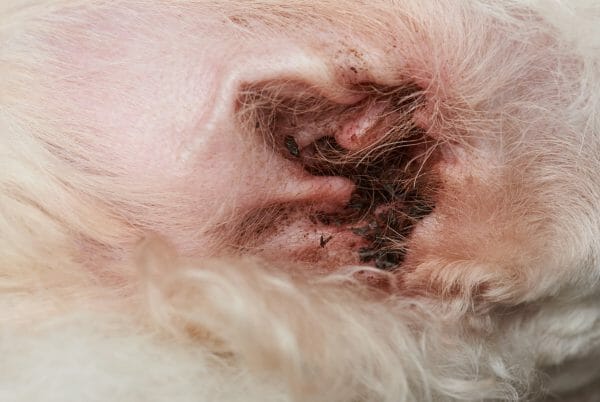Ear Mites Treatment
How Do Dogs Get Ear Mites?
Dogs can become infected with ear mites through several ways, but the most common is through direct contact with other dogs, cats, or animals that are carriers of the mite. If a dog brushes up against another animal that is carrying the parasite, this can be enough for it to transfer to the dog. It is also common to see mites on dogs that mostly spend their time outdoors.
If a dog is found to carry the mite, it is imperative that the dog be quarantined from other pets the mite could transfer to. They are extremely transferable and contagious, easily passing from animal to animal. Dogs of any breed or age can become infected.
It has been found that animals with an immune hypersensitivity, or a weakened immune system, suffer from the mites more than others. Outdoor cats have been found to carry the parasite more than any other animal.
Ear mites, also known by their scientific name of Otodectes cynotis, are part of the arachnid family. However, asking “what do ear mites look like?” is not an easy question to answer. Unlike spiders, they sometimes look like tiny dots that can appear white or red.
However, the mites are virtually invisible to the naked eye, so searching for “dog ear mite pictures” may not yield much. Viewing a sample of the discharge from the dog’s ear under a microscope is one of the only surefire ways of ascertaining whether the parasites are present or not.
 Signs of Ear Mites in Dogs
Signs of Ear Mites in Dogs
While the ear mites do not actually bite the dog, they feed off of their naturally occurring oils and waxes in their external ear canal. This is what causes a dog to be visibly irritated by them. Incessant scratching and clawing at the ears are the most common symptoms which can cause further issues such as hot spots or hematomas on the ear if the dog is not treated.
Some of the most commonly seen symptoms of ear mites in dogs are:
- Constant shaking of the head
- Clawing, scratching, or pawing at the ears
- Secretion of reddish or brownish clumps from the ears
- Inflamed, reddened ears or head
- Cuts and scratches around the ears
These symptoms are more than obvious to most pet owners and should be given special attention. If a dog is left untreated, the situation will only worsen, thereby leading to a severe infestation which could potentially affect other parts of the dog’s body. If cuts are present on the dog, this could also be a gateway to bacterial infection if not cared for. These types of symptoms could also indicate the presence of fleas or ticks.
If these signs are present in a dog, a vet should be promptly seen for the dog to be professionally assessed in order to receive ear mites treatment.
Diagnosing Ear Mites in Dogs
Despite the countless home remedies for ear mites in dogs, it is highly advisable that a dog be seen and assessed by a competent vet before decisions about treatment are made based on an internet search, as tempting and convenient as it is.
This recommendation is based on highly reputable sites like Chewy.com and Petco.com, which advocate for assessments by a vet in cases of mites.
Before ear mites treatment is prescribed, a vet will utilize either an otoscope or a diagnostic test of the discharge from the dog’s ear to determine if mites are present. This is important because other conditions may resemble a mite infestation. Assessment by a vet rules out all possibility of another condition.
Without a vet’s professional assessment, pet owners may assume it is mites and treat it as such. If the treatment or dosage is insufficient, a dog may appear to be better and treatment will be stopped. If the mites are still present and untreated, however, this can cause further complications that may result in hearing loss.
All in all, if mites are suspected, a visit to the vet should be made before ear mite treatment for dogs is given.
How to Get Rid of Ear Mites in Dogs
Whatever is prescribed or recommended by the dog’s vet should be followed exactly.
However, one of the first steps that usually takes place in ear mites treatment is thoroughly flushing out the ears with a canine-approved solution. Not all solutions are safe for dogs, so attention to labels is important.
After the dog’s ears are cleaned out, a vet will recommend a prescription or treatment based on the severity of the mite infection. The usual ear mite medicine for dogs that is prescribed by vets is selamectin, ivermectin, or moxidectin. However, there are countless treatments on sites like Chewy.com that a vet may recommend over those.
A vet’s professional recommendation is always best and should be followed over any other recommendation from a site or by word-of-mouth.
If other animals live within the same household as the pet infected with mites, they all must be treated as well. It is important to let the vet know and ask them for recommendations on how to treat the other animals and environment. Because mites are so mobile, they can jump from pet to pet and live in bedding and blankets.
For this reason, the immediate environment which the infected pet resides should be sanitized and scrupulously cleaned.
Is Mange Associated with Mites?
Mange is caused by what is known as the Demodex mites in dogs. In cases of demodectic mange, the dog’s skin can become hardened, crusty, and red due to inflammation. Contrary to other types of mites, Demodex mites are hidden for long periods of time, deep within the fur of dogs. Sometimes the only indications that mites are present is some redness and hair loss.
Dogs are often infected with these mites by transmission of them from their own mother. The mites burrow in the hair follicles and can remain concealed and undetected indefinitely if the mites are localized in one spot.
In dogs with strong immune systems, the mites stay where they are, and the dog can usually live normally. Dogs with poor immunity may begin to develop symptoms of it.
If Demodex mites are suspected, an examination from a vet will determine this and any further treatment that may be required.
Learn about more top dog health concerns to be the best dog parent you can be for them!




